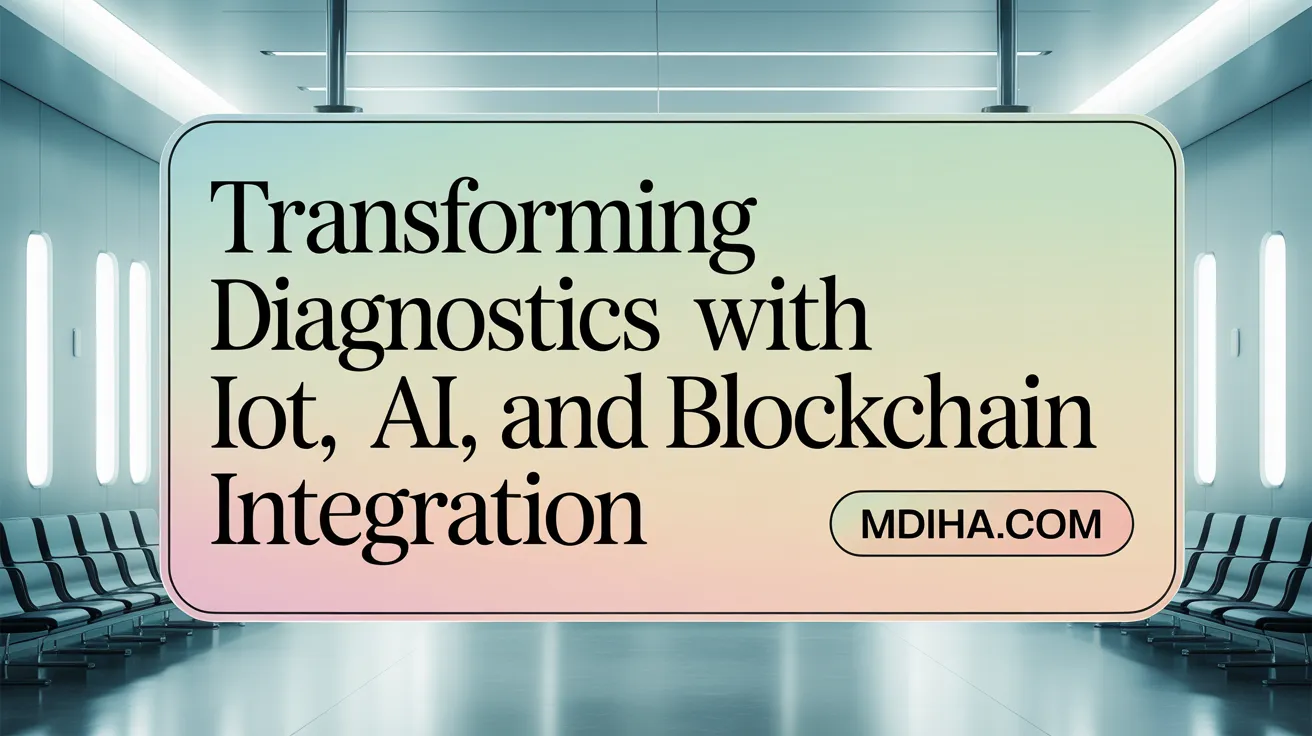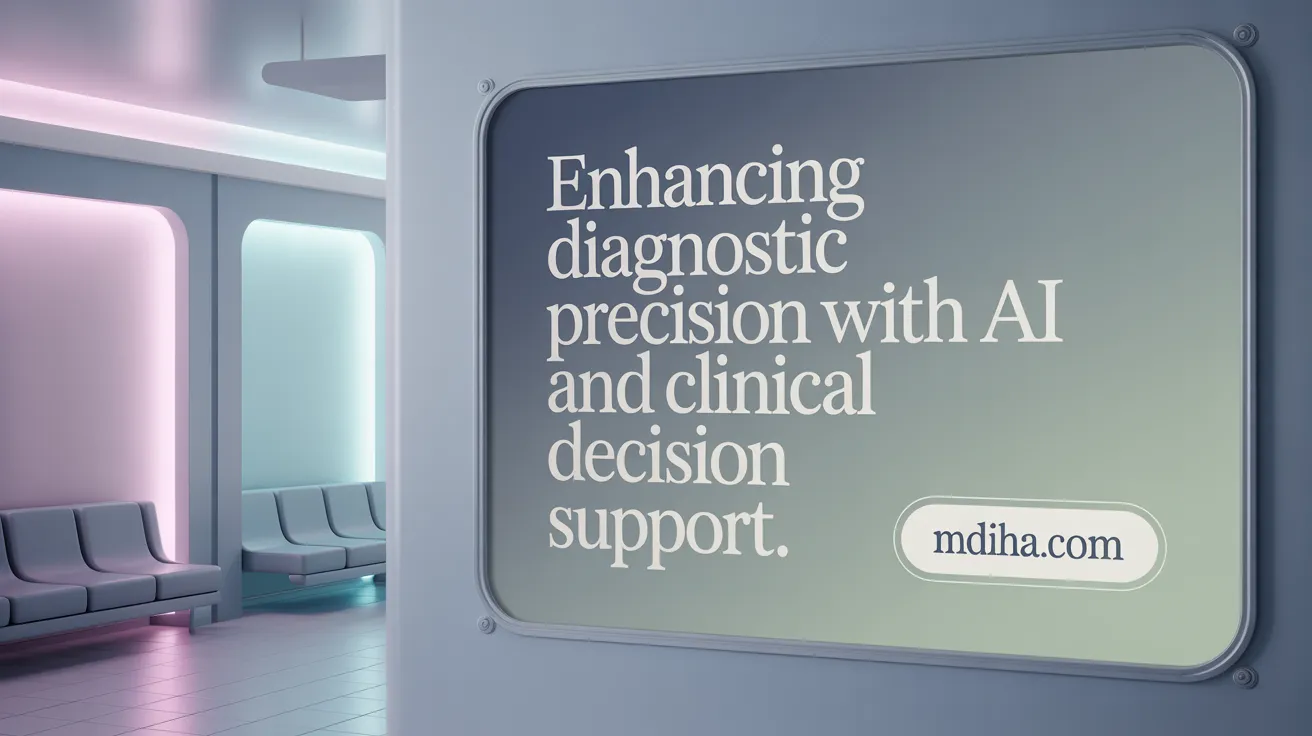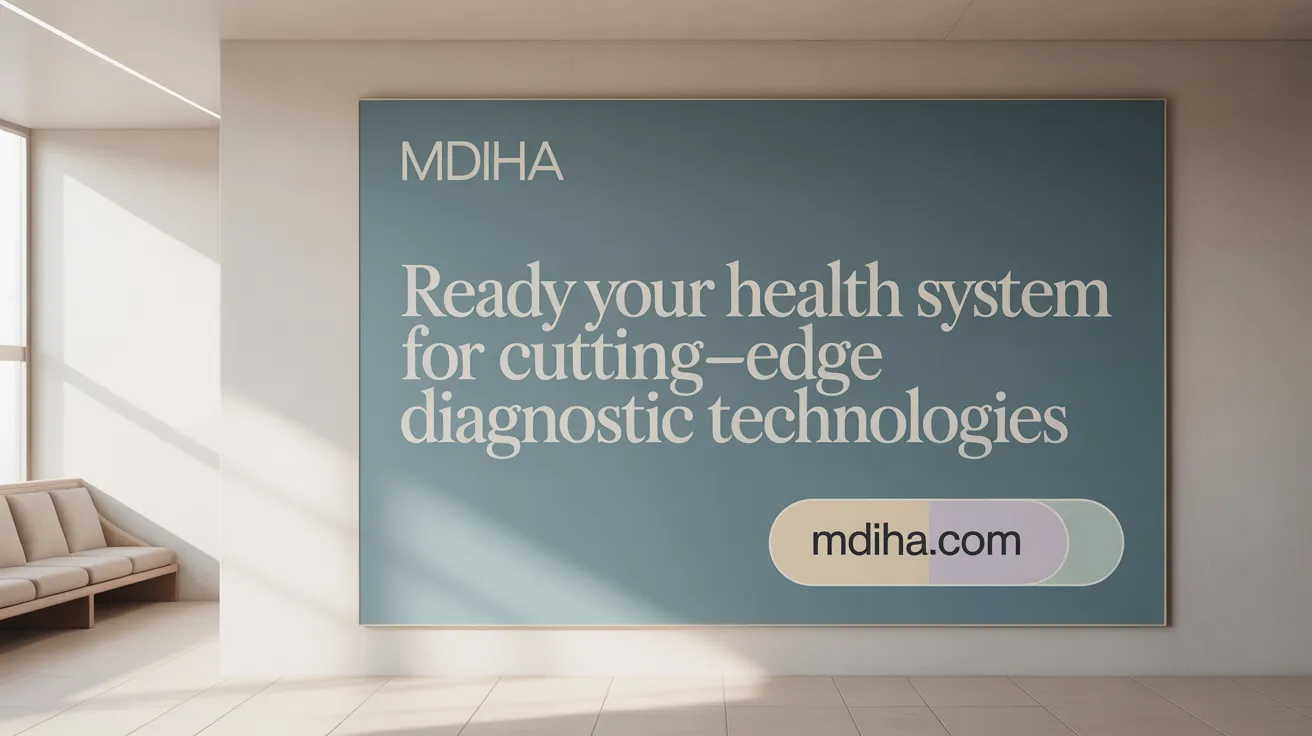Setting the Stage for Tomorrow's Healthcare
As healthcare pivots toward proactive and personalized approaches, advanced diagnostic tools are proving indispensable in detecting health issues early, optimizing treatment, and enhancing patient outcomes. This narrative explores the intricate technologies and strategies underpinning modern diagnostics, their integration into clinical workflows, and the transformative impact they hold for proactive health monitoring.
The Evolution and Impact of Health Information Technology in Diagnostics
Role of Health IT in healthcare diagnosis
Health Information Technology (Health IT in healthcare) plays a fundamental role in modern healthcare by supporting the diagnostic process through systems like Electronic health records (EHRs), Clinical decision support tools, laboratory and imaging information systems, and Patient engagement tools. These technologies capture comprehensive patient data, shape clinician workflows, and facilitate timely information exchange essential for accurate diagnosis.
Importance of usability and human-centered design in health IT
A critical component of effective Health IT is usability, which emphasizes simplicity, efficiency, and clinician satisfaction. Human-centered design in Health IT principles ensure that systems provide intuitive interfaces with easy data retrieval, minimizing cognitive overload and workflow disruption. Engaging end-users during development improves the design of features such as problem lists and natural language processing tools, which help clinicians manage complex health data more effectively.
Challenges with interoperability and clinical workflows
Despite its benefits, Health IT faces challenges, particularly with Health IT interoperability issues—the ability of diverse systems to exchange and use patient information seamlessly. Inconsistent standards and slow progress have led to fragmented data, causing incomplete or outdated patient records that can impede diagnostic accuracy. Additionally, integrating Health IT into clinical workflows requires flexible and modular designs to avoid workflow inefficiencies that may affect clinical decision-making.
How health IT improves diagnostic accuracy and communication
When well-implemented, Health IT enhances diagnostic accuracy by providing evidence-based, patient-specific information at the point of care, notably through Clinical decision support benefits. It also improves communication among clinicians and patients by enabling timely information flow and supporting teamwork and role delegation. Emerging technologies like Telemedicine technologies, mHealth innovations, and Wearable devices in healthcare diagnosis further augment diagnostic capabilities by enabling remote monitoring and early detection, although they require careful integration to overcome barriers such as data quality and acceptance.
Wearable Technologies: Revolutionizing Real-Time Health Monitoring

What types of wearables and physiological data are typically gathered?
Wearable technologies include devices like smartwatches and fitness trackers, biometric clothing, smart contact lenses, and implanted sensors. These devices collect a broad range of physiological data such as heart rate, blood pressure, oxygen saturation, body temperature, sleep quality, activity levels, and hydration status. This continuous data collection enables early detection and monitoring of health conditions as described in Wearables in modern healthcare.
What advanced sensors are used for monitoring specific health conditions?
Advanced wearable sensors can monitor complex health issues including arrhythmias, diabetes, fall risk, and hydration levels. For example, personal ECG patches detect heart electrical activity to identify arrhythmias, while implanted sensors assess blood flow anomalies as demonstrated in Digital Twins for Blood Flow Anomaly Detection. Such specialized sensors support tailored disease prevention and management.
What are the integration challenges related to wearable devices?
Integrating wearable data into clinical workflows poses challenges such as ensuring secure data transmission, maintaining patient privacy, and achieving interoperability across diverse healthcare IT systems. Secure informatics platforms and adherence to privacy and ethical standards are essential to support the safe and effective use of wearable data, as outlined in IoT in healthcare monitoring and discussed in relation to Health IT interoperability issues.
What future innovations are expected in wearable sensor technology?
Future developments in wearables promise improved sensor designs for greater accuracy, energy-harvesting technologies to enhance device longevity, and advanced analytics capabilities to predict and prevent diseases. Enhanced integration with healthcare workflows will further optimize personalized patient care through continuous monitoring, as discussed in Wearables in modern healthcare and broader Emerging technologies in healthcare.
Emerging Technologies Powering Advanced Diagnostics: IoT, AI, and Blockchain

How Are IoT, AI, and Blockchain Combining to Personalize Healthcare?
Emerging technologies are merging to create highly personalized healthcare management systems. Internet of Things (IoT architecture in healthcare monitoring) devices, artificial intelligence (AI), and blockchain work in concert to transform diagnostics and patient care. IoT sensors continuously gather real-time physiological data, AI analyzes this large-scale health information to detect patterns and predict diseases, while blockchain ensures that data remain secure, validated, and transparently shared among providers.
What Is the IoT Architecture Behind Real-Time Patient Monitoring?
IoT healthcare systems are structured across four layers:
- Sensing layer: Collects vital signs like heart rate, blood pressure, and respiration using wearable or implantable sensors.
- Communication layer: Transmits data through wireless technologies such as Bluetooth Low Energy and Wi-Fi.
- Network storage layer: Securely stores the data for accessibility.
- Application layer: Visualizes patient information and interfaces with clinical workflows for informed decision-making.
This layered design enables continuous, remote, and preventive health monitoring (IoT architecture in healthcare monitoring).
In What Ways Does AI Enhance Diagnosis and Prediction?
AI techniques, including machine learning and big data analytics, sift through complex clinical datasets to:
- Diagnose diseases more accurately and earlier.
- Forecast patient risks and health trends.
- Support personalized treatment plans.
The vast number of FDA-approved AI algorithms in diagnostic imaging, particularly in imaging, testify to AI’s growing influence in improving diagnostic accuracy and efficiency.
How Does Blockchain Contribute to Secure Health Data Management?
Blockchain provides decentralized, immutable storage ideal for sensitive health data. It supports:
- Secure patient recordkeeping with transparent access controls.
- Validation of health data to reduce errors and fraud.
- Streamlined financial transactions and supply chain management via smart contracts.
Its application addresses critical privacy and security concerns associated with digital health data (Emerging technologies in healthcare.
What Are the Challenges in Deploying These Emerging Technologies?
Despite their potential, these technologies face hurdles:
- Ensuring interoperability among diverse systems.
- Protecting patient privacy and complying with regulations.
- Scalability and integration with existing clinical workflows.
- Gaining user acceptance among healthcare providers and patients.
Ongoing research and collaboration aim to overcome these gaps to realize the full benefits in advanced diagnostics (Challenges in healthcare technology deployment.
From Reactive to Proactive Healthcare: The Strategic Shift
What distinguishes proactive healthcare models and what advantages do they offer?
Proactive healthcare involves both providers and patients actively managing health to prevent diseases and detect issues early. Unlike reactive care—which responds primarily to symptoms or complications—proactive care emphasizes early intervention and lifestyle adjustments to maintain wellness. This approach can reduce the incidence of severe, costly chronic diseases like heart disease and diabetes, thus improving long-term patient outcomes. Learn more about Reactive vs. Proactive Healthcare Models.
How does predictive modeling and patient engagement contribute to proactive healthcare?
Predictive modeling leverages clinical, financial, and consumer data to identify patients at increased risk of specific conditions. By targeting these individuals with preventive measures, healthcare providers can intervene earlier and more effectively. Additionally, sophisticated patient engagement tools facilitate personalized communication and encourage patients to participate actively in their health management. These tools improve adherence to preventive recommendations and support sustained health behavior changes. For additional insights refer to Proactive Health Strategies and Patient Engagement.
What are the mental health and quality-of-life benefits linked with proactive diagnostics?
Proactive health strategies, such as routine screening including CT scans, promote early detection of potential problems, which increases patient peace of mind. Detecting health issues before symptoms emerge helps avoid the physical and emotional burden of advanced disease. This early action supports healthier aging and improved mental well-being by reducing anxiety linked to health uncertainties and fostering a sense of control over one’s health. Further details can be found at Mental Health Benefits of Proactive Healthcare.
How does proactive healthcare impact healthcare costs and organizational profitability?
By focusing on prevention and early intervention, proactive healthcare aims to reduce long-term costs associated with treating advanced illnesses and complications. Research shows that reactive healthcare accounts for the majority of healthcare expenditure. Moreover, proactive strategies enhance patient retention and satisfaction, improving profitability for healthcare organizations. The triple aim of healthcare—better patient experience, improved population health, and cost reduction—is thus supported by these proactive models. More information available at Healthcare Triple Aim and Proactive Models.
Advanced Diagnostic Imaging: Balancing Clinical Benefits with Risks

Types of Advanced Imaging and Their Clinical Applications
Advanced diagnostic imaging primarily includes Magnetic Resonance Imaging (MRI), Computed Tomography (CT), and nuclear medicine techniques such as Positron Emission Tomography (PET). These technologies are vital for the early detection of diseases, enabling timely and appropriate interventions. For example, CT and MRI scans can detect abnormalities in tissues and organs with high precision, while PET scans provide functional information useful in oncology and neurology. For more details, see Advanced diagnostic imaging overview.
Risks Related to Overuse, Especially Ionizing Radiation Exposure
Despite their benefits, the overuse of advanced imaging poses significant risks. CT scans are a common source of ionizing radiation, which has been associated with increased cancer risk. It is estimated that up to one-third of advanced imaging procedures may be clinically inappropriate or add minimal diagnostic benefit, unnecessarily exposing patients to radiation and driving up healthcare costs. Refer to Ionizing radiation exposure risks and cancer risk from CT scans for comprehensive information.
Regulatory and Policy Measures Governing Imaging Use
To address these concerns, legislation such as the Medicare Improvements for Patients and Providers Act (MIPPA) mandates accreditation standards for advanced imaging providers, enhancing quality and patient safety. Furthermore, regulations like Stark I and II aim to curb physician self-referrals, which have been linked to overutilization of imaging services. Private insurers also use radiology benefit management programs to reduce unnecessary imaging. Further reading is available in the section on MIPPA accreditation requirements and Stark law regulations.
Industry Trends Affecting Availability and Cost Control
The advanced imaging sector has experienced consolidation, with fewer but larger providers dominating the market. While this can streamline services, strict regulations and reimbursement cuts have emerged as strategies to manage rising costs. However, care must be taken to ensure that such measures do not inadvertently reduce patient access to necessary imaging services. For a detailed overview, see Imaging provider consolidation and regulation.
Balancing the clinical benefits of advanced imaging with the associated risks requires ongoing vigilance through appropriate use, patient safety initiatives, and robust regulatory frameworks.
Clinical Decision Support and Artificial Intelligence in Diagnostics

How AI and CDS tools improve diagnostic accuracy and decision-making
Clinical decision support ([CDS] tools) and artificial intelligence (AI) have become transformative in enhancing diagnostic accuracy. CDS systems provide healthcare professionals with patient-specific, evidence-based information at the point of care. This support aids in clinical reasoning, timely access to health information, and informed decision-making. AI algorithms analyze extensive patient data rapidly, offering insights beyond traditional diagnostic tools. By reducing cognitive overload and alert fatigue, these technologies refine clinicians' workflow efficiency and diagnostic precision.
FDA approvals and real-world applications of AI in imaging
AI has notably advanced diagnostic imaging, with nearly 400 FDA-approved AI algorithms in diagnostic imaging for radiology applications. These tools assist in detecting abnormalities such as lung nodules, breast lesions, and other pathological signs with higher accuracy and speed. Real-world examples include machine learning models that integrate wearable data for early detection of cardiac anomalies and digital twins for monitoring blood flow, demonstrating AI's growing role in personalized diagnostics (Wearable Devices in Patient Care).
Balancing AI assistance with clinician autonomy
While AI enhances diagnostics, maintaining clinician autonomy is essential. AI is designed to augment—not replace—healthcare professionals. Effective integration requires a balance where clinicians benefit from AI's data processing capabilities while retaining control over clinical judgments. Avoiding overreliance on AI and preventing alert fatigue remains a priority, ensuring that human-centered design in Health IT principles focus on usability, transparency, and supportive decision-making.
Growth projections and future human-centered AI design
The adoption of AI in diagnostics is expected to accelerate, with surveys indicating that over 48% of hospital leaders anticipate health systems will have the infrastructure for widespread AI integration by 2028. Future developments aim to prioritize human-centered AI design that supports patient safety, optimizes user interaction, and enhances clinical workflows. Continuous improvement and validation of AI tools will be pivotal in promoting trust and maximizing their diagnostic impact (How AI Improving Diagnostics, Decision-Making, and Care.
Diagnostic Medical Devices and Tools: An Overview of Key Instruments
What Are Common Diagnostic Devices and Their Functions?
Several diagnostic medical devices serve essential roles in identifying and monitoring health conditions. Key instruments include:
- Stethoscopes: Listen to heart and lung sounds to diagnose pneumonia, arrhythmia, and other conditions. Electronic versions enhance sound quality and enable recording.
- Sphygmomanometers: Measure blood pressure; manual mercury devices are most reliable, though digital models offer portability.
- Ophthalmoscopes and Otoscopes: Used for examining the eye fundus and ear canal, diagnosing glaucoma, retinal detachment, and ear infections.
- Thermometers: Quickly measure body temperature via oral, ear, or other methods.
- Advanced Imaging Devices: MRI, CT, and PET scans assist in early disease detection and treatment planning but require appropriate use to avoid unnecessary radiation exposure. See Advanced diagnostic imaging overview.
How Do Wearable Diagnostic Devices and Biosensors Contribute to Healthcare?
Wearables in modern healthcare provide continuous real-time monitoring of vital signs like heart rate, blood pressure, and oxygen levels. Examples include:
- Smartwatches and Fitness Trackers: Track activity levels and physiological parameters.
- Implanted Sensors and Personal ECG Patches: Detect arrhythmias and monitor cardiac activities non-invasively.
- Temperature Monitoring Patches: Detect early signs of illness continuously.
Wearables enable early detection of subtle health changes, facilitating personalized interventions and improving disease management.
Why Are Accuracy Indicators Like Sensitivity and Specificity Important?
Diagnostic Testing Accuracy ensures that medical tests reliably detect or exclude diseases. Important indicators include:
- Sensitivity: The ability of a test to correctly identify patients with the disease (true positives).
- Specificity: The ability to correctly identify those without the disease (true negatives).
- Positive Predictive Value (PPV) and Negative Predictive Value (NPV): Likelihood that test results reflect true disease status.
Understanding these metrics helps clinicians interpret test results confidently and reduce diagnostic errors.
How Is Diagnostic Data Integrated Into Proactive Health Monitoring?
Modern Health IT in healthcare systems and wearable devices for health monitoring collect diagnostic data that feed into Reactive vs. Proactive Healthcare Models aiming for early disease detection and prevention. Key features include:
- Continuous data collection and remote monitoring via wearable biosensors and the IoT architecture in healthcare monitoring.
- Integration into electronic health records (EHRs) and clinical decision support tools to guide timely interventions.
- Use of AI and machine learning to predict health risks and personalize care.
This integration promotes timely communication between patients and providers, supporting improved health outcomes and reduced healthcare costs.
| Device Type | Function | Impact on Care |
|---|---|---|
| Traditional Diagnostic | Heart, lung sounds, blood pressure | Early disease detection, monitoring |
| Wearables & Biosensors | Continuous vital sign monitoring | Early detection, personalized treatment |
| Imaging Technologies | Visualize internal body structures | Accurate diagnosis, treatment planning |
| Accuracy Metrics | Indicate test reliability | Guide test interpretation, reduce errors |
| Health IT Integration | Data aggregation, decision support | Enables proactive health management |
Preparing Health Systems for the Integration of Advanced Diagnostics

What does system readiness involve for advanced diagnostics?
System readiness for advanced diagnostics requires substantial investment in laboratory infrastructure and the training of a skilled workforce. Facilities must be equipped with modern sequencing and genomic technologies that support new diagnostic methods. Additionally, health systems need to establish secure data storage solutions to handle sensitive genetic and clinical information.
How are data systems and analytics integrated?
A critical component is the integration of data analytics platforms that can process and interpret large volumes of genomics and clinical data. These data systems enhance clinical decision-making by providing actionable insights and personalized diagnostics. Incorporating advanced analytics allows health providers to implement targeted therapies and improve patient outcomes.
What regulatory frameworks and evaluations are necessary?
Effective implementation demands adapting regulatory frameworks to address the unique characteristics of advanced diagnostics. This includes developing value assessment models that consider both clinical utility and cost-effectiveness. Routine data collection and continuous evaluation are essential to ensure safety, efficacy, and economic sustainability in healthcare delivery.
Why is continuous improvement required in technology and protocols?
The field of advanced diagnostics is rapidly evolving, making ongoing technology updates and protocol refinements necessary. Health systems must proactively monitor advancements and adjust their practices to maintain high-quality care standards. Continuous innovation ensures early disease detection capabilities and the efficient management of emerging diagnostic tools, ultimately reducing healthcare burden and costs.
Embracing the Diagnostic Revolution for a Healthier Future
Advanced diagnostic tools lie at the heart of a transformative shift toward proactive health monitoring. By leveraging innovations in health IT, wearable technologies, AI, and integrated data systems, healthcare providers can anticipate and address medical conditions earlier than ever before. The ongoing challenge is to ensure that these technologies are seamlessly integrated, secure, user-friendly, and accessible, fostering more effective care and improved patient outcomes. As clinics like the Medical Institute of Healthy Aging champion personalized longevity and health optimization, embracing these advanced diagnostics paves the way for a future where proactive, precise healthcare is the norm rather than the exception.
